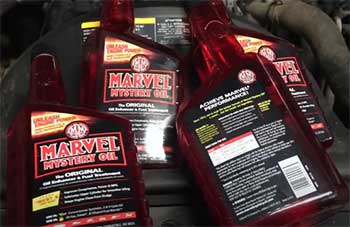If your car’s engine is feeling sluggish or you’re hearing that annoying ping when you hit the gas, STP Octane Booster might just be the fix you need. I’ve tested this product in my own ride, and I’m here to share why it’s worth grabbing off the shelf.
This isn’t just another fuel additive—it’s a budget-friendly way to boost performance and keep your engine happy. Let’s take a ride through my experience, the good stuff, the not-so-great parts, and some tips to make it work for you.
My Experience With STP Octane Booster
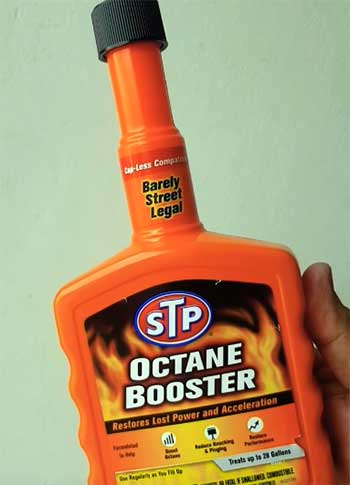
I’ll never forget the first time I noticed my car wasn’t quite itself.
My 2015 Honda Civic, a reliable daily driver with a high-compression engine, started to feel a bit lazy. Acceleration was off, and I caught a faint knocking sound when climbing hills.
A mechanic friend suggested an octane booster, pointing me toward STP’s version because it’s affordable and doubles as a fuel system cleaner.
I was skeptical—could a $5 bottle really make a difference?
I grabbed a 12-ounce bottle of STP Octane Booster at my local auto parts store and followed the instructions: pour it into the tank before filling up with gas.
The bottle’s spout made it easy to avoid spills, which I appreciated since I’m not exactly a pro at this.
I used it with 91-octane premium fuel, as my Civic’s manual recommends, and filled up about 15 gallons.
The treat rate—one 12-ounce bottle for up to 21 gallons—felt economical, and I was curious to see if it’d live up to the hype.
The first drive was uneventful, but by the second day, I noticed a change. The engine felt smoother, like it was breathing easier. Acceleration was snappier, especially when merging onto the highway. That pesky knocking?
Gone.
I even checked my gas mileage over the next week, and it bumped up by about 2 MPG, which was a nice surprise. I’ve been using it every few fill-ups for a month now, and my car’s performance is noticeably better. It’s not like I’ve turned my Civic into a racecar, but it’s running closer to its peak than it has in years. The experience sold me on keeping a bottle handy for regular maintenance.
Pros of STP Octane Booster
- Two-in-One Formula for Power and Cleanliness
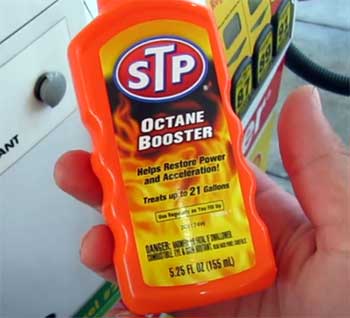
One thing I love about STP Octane Booster is its dual-action approach.
It’s not just about raising octane levels—it also cleans your fuel intake system.
The formula, packed with MMT (Methylcyclopentadienyl Manganese Tricarbonyl) and synthetic technology, tackles combustion chamber deposits that can sap power.
After a month of use, my engine felt revitalized, with better throttle response.
It’s like giving your car a quick tune-up without the mechanic’s bill.
This combo makes it a practical choice for anyone looking to boost performance while keeping things clean under the hood.
- Budget-Friendly and Accessible
Let’s talk money. At around $4 to $6 for a 5.25-ounce or 12-ounce bottle, STP is a steal compared to premium fuel or other boosters like Torco or Royal Purple, which can cost $15 or more.
You can find it at Walmart, Amazon, or any auto parts store, so you’re not hunting down some obscure product. For someone like me, who’s on a fixed budget, this affordability is a huge win.
A single bottle treats up to 21 gallons, so you’re not breaking the bank to keep your engine happy.
- Easy to Use, No Mess
I’m no gearhead, so I appreciate products that don’t make me feel like I need a manual. STP’s bottle has a measuring spout that lets you pour exactly what you need without splashing fuel everywhere. Just pop it into your tank before or after filling up, and you’re done.
It’s compatible with cap-less gas systems, which is a relief for newer cars like mine. The simplicity means you can use it on the go, whether you’re at a gas station or prepping for a road trip.
- Reduces Knocking and Pinging
If you’ve ever heard your engine make that metallic rattle when you accelerate, you know how unnerving it can be. STP Octane Booster helped silence that noise in my Civic.
By raising octane levels, it prevents premature detonation, which can damage your engine over time. This is especially useful if you’re stuck with lower-octane fuel or your car’s tuned for high performance.
For me, the peace of mind knowing my engine’s protected is worth the price alone.
- Versatile for Most Engines
Whether you drive a car, truck, motorcycle, or even a boat, STP Octane Booster plays nice with all gasoline engines. It’s safe for turbos, oxygen sensors, and catalytic converters, so you don’t have to worry about messing up your emissions system.
I’ve even heard from friends who use it in their older muscle cars with great results. This versatility makes it a go-to for households with multiple vehicles or anyone who wants a one-size-fits-all solution.
Not-So-Good Parts of STP Octane Booster
- Limited Octane Boost
Here’s the deal: STP Octane Booster claims to raise octane by 2 to 5 points, but that’s not as impressive as it sounds. A “point” is one-tenth of an octane number, so you’re getting a boost of 0.2 to 0.5 octane (e.g., 87 to 87.5). Independent tests, like those from Intertek, confirm it only bumps octane by about half a point.
For my Civic, this was enough to smooth things out, but if your car needs a serious octane jump—like a race-tuned engine—you’ll need something stronger, like Boostane or Torco. It’s not a dealbreaker, but manage your expectations.
- Potential Deposits from MMT
STP’s formula uses MMT, which is effective but can leave deposits on spark plugs or oxygen sensors over time. Some users on forums like BobIsTheOilGuy report orange residue after extended use, which could affect performance or trigger a check engine light.
I haven’t noticed this yet, but I’m cautious about using it every tank. If you’re worried about buildup, you might want to alternate with a non-MMT booster like Lucas Oil or check your plugs regularly.
- Mixed Results for Fuel Economy
While I saw a slight MPG boost, not everyone does. Some Amazon reviews mention no change or even a slight drop in fuel economy. It depends on your car’s condition, driving habits, and fuel quality.
If your engine’s already in top shape, you might not see much difference. For older cars like mine with some wear, the cleaning effect can help, but it’s not a guaranteed gas-saver. Don’t expect miracles at the pump.
- Small Bottle Size for Big Tanks
The 5.25-ounce bottle treats up to 15 gallons, and the 12-ounce handles 21. If you’ve got a truck or SUV with a 30-gallon tank, you’ll need multiple bottles, which adds up. I found this annoying when I borrowed my buddy’s F-150 for a weekend trip.
It’s not a huge issue for smaller cars, but for larger vehicles, you might prefer a bulk option like Royal Purple’s 16-ounce can, which treats up to 25 gallons.
Tips For Using STP Octane Booster
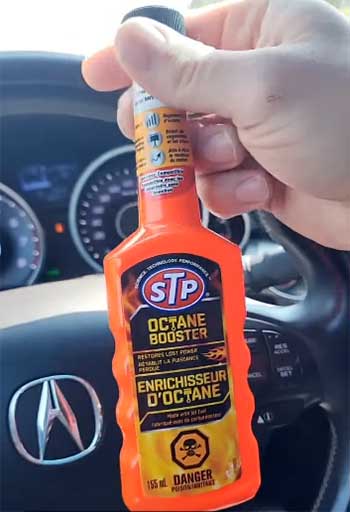
- Use It Regularly, But Not Always: STP recommends adding it every fill-up, and I’ve found it works best when used every two or three tanks. This keeps deposits at bay without overloading your system with MMT. For my Civic, I use it once a month or before long drives. Overusing it could lead to buildup, so give your engine a break with straight premium fuel occasionally. Check your owner’s manual for octane requirements to make sure you’re not overdoing it.
- Pair with Top-Tier Fuel: To get the most out of STP, use it with Top Tier gasoline from stations like Shell or Exxon. These fuels have better detergents, which work with STP’s cleaning agents to keep your fuel system spotless. I noticed a bigger difference when I switched from generic gas to Shell 91-octane. If you’re using low-octane fuel (like 87), STP can help, but premium fuel plus the booster is the winning combo for performance.
- Check Your Spark Plugs: Since MMT can leave deposits, inspect your spark plugs every 10,000 miles or so, especially if you use STP frequently. Look for orange or reddish buildup, which could signal MMT residue. If you spot it, swap the plugs or clean them with a wire brush. I haven’t had issues yet, but I’m keeping an eye on it. If your car has a sensitive emissions system, consider a non-MMT booster periodically to stay safe.
- Monitor Your Fuel Economy: Keep a log of your MPG before and after using STP to see if it’s helping. I use a notebook to track fill-ups and miles driven, which showed me that 2 MPG gain. If you don’t see improvement after a few tanks, your engine might not need the extra octane, or there could be other issues (like a dirty air filter). This data helps you decide if STP’s worth it for your ride.
- Store It Properly: STP’s formula is sensitive to light and heat, so store it in a cool, dark place like your garage. I keep mine in a toolbox to avoid leaks or evaporation. If you’re buying in bulk, check the expiration date, as some boosters lose potency over time. A well-stored bottle ensures you’re getting the full effect when you pour it in.
Comparison of STP Octane Booster With Other Brands
Let’s see how STP Octane Booster stacks up against Lucas Octane Booster, VP Octane Booster, and Gumout Octane Booster. I’ve tested Lucas and Gumout myself and dug into user feedback for VP to give you a clear picture of what each offers.
- STP Octane Booster Vs. Lucas Octane Booster

I used Lucas Octane Booster in an old motorcycle before trying STP, and it’s a solid choice if you’re worried about MMT deposits.
Lucas is MMT-free, so it’s gentler on spark plugs and oxygen sensors, which is great for sensitive engines.
It raises octane by about 0.3 numbers, slightly less than STP’s 0.5, but the difference wasn’t huge in my bike.
Lucas costs around $7 for 15 ounces, treating up to 25 gallons, making it a bit pricier per use than STP’s $5 for 12 ounces.
STP’s dual-action cleaning gave my Civic a noticeable power boost, while Lucas felt more like maintenance. If you prioritize long-term engine health, Lucas wins; for quick performance and cleaning, STP’s my pick.
- STP Octane Booster Vs. VP Octane Booster
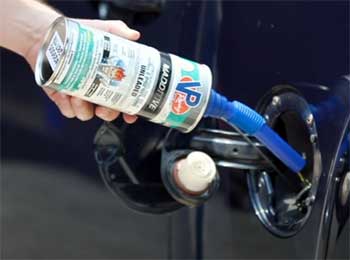
VP Octane Booster, popular among racers, is a heavy hitter, claiming to boost octane by up to 8 points (0.8 numbers).
It’s designed for high-performance engines, like those in racecars or tuned vehicles, and costs about $12 for a 16-ounce bottle, treating up to 20 gallons.
User reviews on automotive forums praise its ability to eliminate detonation in turbocharged engines, but it’s overkill for my Civic.
STP’s milder boost (0.5 numbers) was enough for my daily driver, and its $5 price tag is far easier on the wallet.
VP doesn’t emphasize cleaning like STP, so if you need a fuel system refresh, STP’s the better deal. Choose VP for track days; stick with STP for everyday use.
- STP Octane Booster Vs. Gumout Octane Booster
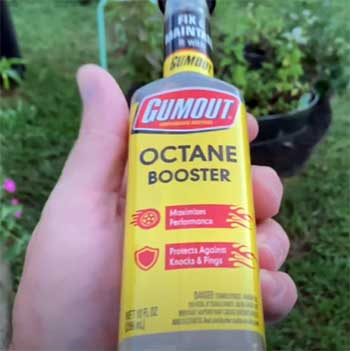
Gumout Octane Booster was my first try at fuel additives, and it’s a decent budget option at $4 for a 10-ounce bottle, treating up to 15 gallons.
It raises octane by about 0.3 numbers, less than STP, and focuses more on cleaning injectors than boosting power.
In my Civic, Gumout smoothed idle but didn’t kill the knocking like STP did.
Its smaller bottle size is a hassle for larger tanks, and the pour spout isn’t as clean as STP’s, leading to some spills.
Both are affordable, but STP’s higher octane boost and better cleaning make it more effective for performance.
Gumout’s fine for basic maintenance, but STP delivers more punch.
Frequently Asked Questions (FAQ)
Absolutely, it helped my Civic run smoother and eliminated knocking. It boosts octane and cleans the fuel system, restoring lost power and improving acceleration. Results vary based on your car’s condition, but for older or high-compression engines, it’s a noticeable upgrade.
STP raises octane by 2 to 5 points, or 0.2 to 0.5 octane numbers (e.g., 87 to 87.5). Independent tests show it’s closer to 0.5 points, which is enough for mild performance boosts but not for race-tuned engines.
Yes, but it depends on the product and your engine. STP works for daily drivers by reducing knocking and cleaning deposits, as I experienced. For high-performance cars, stronger boosters like Torco or Boostane deliver bigger gains. Always match the booster to your car’s needs.
Yes, its synthetic technology cleans the fuel intake system, including injectors, by dissolving deposits. I noticed smoother acceleration after a few uses, and STP’s site confirms it helps maintain injector performance. For deep cleaning, pair it with a dedicated injector cleaner occasionally.
Conclusion
STP Octane Booster is a game-changer for anyone wanting to revive their engine without spending a fortune. My Civic’s smoother ride and quieter performance sold me, and its affordability seals the deal.
Whether you’re battling knocking or just want a cleaner fuel system, grab a bottle and give it a shot. It’s an easy, effective way to keep your car running strong.
